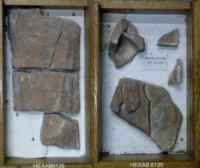 Click on
Click onThumbnail
for
12 photos
In 1907 important fragments of Anglo-Saxon figure-sculpture were found “in a hole near the west end of the nave”. They were described by the finders (Mr C C Hodges and the Revd E S Savage) as a crucifixion and an ecclesiastic vested in a chasuble. The finders did not illustrate these stones; but Mr W G Collingwood illustrated the crucifixion in his Northumbrian Crosses (1927), Fig.36. Thereafter the stones remained unnoticed until they were re-discovered in 1965 in a wooden box in the vestry. They have now been fully described and illustrated by Dr H M Taylor, Vice-Chancellor of the University of Keele, in Archæologia Æliana, Vol.XLIV, 1966. Dr Taylor has also provided the frames in which the six fragments are now displayed and the drawings which illustrate his suggested reconstruction of the sculptures in their original form. The original finders suggested that these stones formed part of the adornments which Acca (Bishop of Hexham 709–732) is known to have provided for his church.
Pre-2014 in display boxes [HEXAB110] near west end of south wall of nave.
2012 “This group of fragments, now in a display case near the south west door of the nave almost certainly represent the remains of a large wall panel depicting the crucified Christ and, to judge by manuscript parallels, belong to the late 7th or very early 8th century – and thus to a Wilfridian period. What is doubly important about them is that they are carved from Hartlepool or Roker dolomite – not a stone otherwise attested at Hexham but one which is local to, and exploited at, Monkwearmouth. It may well have been a gift from Benedict Biscop's monastic foundation. It is proposed to include these fragments in the secure exhibition space.” [Hexham Abbey collection faculty document.pdf, §6]
Mar 2022: removed for examination by David Edwick and extraction from the plaster-of-Paris in which they had been mounted.
Dec 2022: examined by Richard Bailey and Elizabeth Coatsworth.
Oct 2023: type of stone confirmed by Dave Schofield; fragments removed for further study in preparation for a new display in 2024.
May 2024: displayed in historically correct formation with drawing by David Edwick who had also removed the fragments from the Plaster-of-Paris mounts.
EP 184/145 (1965–1966) Correspondence with University of Keele re Saxon Stone. Includes 2 photos and 3 drawings of stones.
Archæologia Æliana Series 4 vol 44 pp49–60: Taylor, H McCarter, (1966) Rediscovery of important Anglo-Saxon sculpture at Hexham [see URL link]